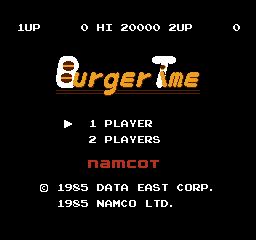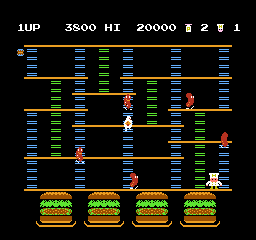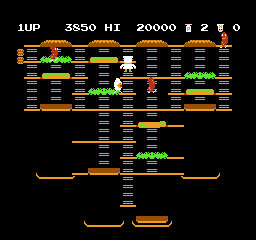Publisher: Data East
Year: 1987
Genre: Action
“In a world without sanitation regulations, one man stands ready to give the people what they want: delicious piping hot burgers. This master chef prepares his creations the only way he knows how: through the power of stepping on food. But when a group of rogue hot dogs and fried eggs threaten to put him on the grill, will he be able to turn the tables on the food rebellion, or will BurgerTime be seasoned… with death?”
-The back of the BurgerTime box, except not actually.

In BurgerTime (CamelCase spelling is intentional), you play the role of Peter Pepper, a chef who prepares simple, yet presumably delicious burgers by mixing-and-matching strange burger toppings that he walks on. Though I have my doubts about this dubious approach to culinary excellence, I can’t argue that the end result isn’t a set of four perfect-looking people-sized burgers.
The gameplay is fairly simple – you climb up and down ladders and scamper across the assorted burger parts while being chased by murderous hot dogs, fried eggs and pickles. The only weapon in your arsenal is pepper, which stuns these vicious comestibles. When Peter finishing crossing a given sandwich piece (or manages to, by any means, step on each discrete segment thereof) it falls down a level and, potentially, pushes down or crushes anything beneath them. If you manage to sandwich one of the more aggressive foodstuffs in the process, you get bonus points and, presumably, a more interesting burger.

At this time I’d like to give a bit of background into the nature of BurgerTime itself*. BurgerTime originated as an arcade game utilizing the Deco Casette System, which was an early attempt at giving arcades flexibility to change the software on an arcade cabinet without actually buying a new cabinet. After its arcade debut, it was ported to just about every video game system that it could be ported to, until its final unemulated release on the NES (its subsequent Wii release is emulated, and therefore identical). So, by the time it made it to the Nintendo, it already had a reputation and a lot of people had already played it on other systems.

The unfortunate fact, from my perspective, was that the Nintendo did next to nothing to improve on the game despite being the most modern video game system widely available at the time. Issues from previous versions of the game abound: Peter Pepper moves slowly and clumsily and has difficulty getting off ladders anywhere but the top and bottom. The difficulty curve on the game is sharp, and the NES’s additional processing was put to good use in one department: the maximum enemy count is higher than in previous versions.
John’s Rating: 3.0 out of 5.0. Despite my criticisms, once you get the hang of it (and start to anticipate the enemy’s movement patterns), BurgerTime is honestly a lot of good, wholesome Nintendo Hard fun. I just wish they would have made a NES-released sequel / update to this game.One final note of criticism: the music is probably the worst of any NES game I’ve reviewed so far. Not only is it painfully repetitive, the loop ends with an incomplete cadence that will never EVER resolve no matter how many times you listen to it. I wasted two years as a music major, so this was especially obnoxious for me. You annoyance may vary.